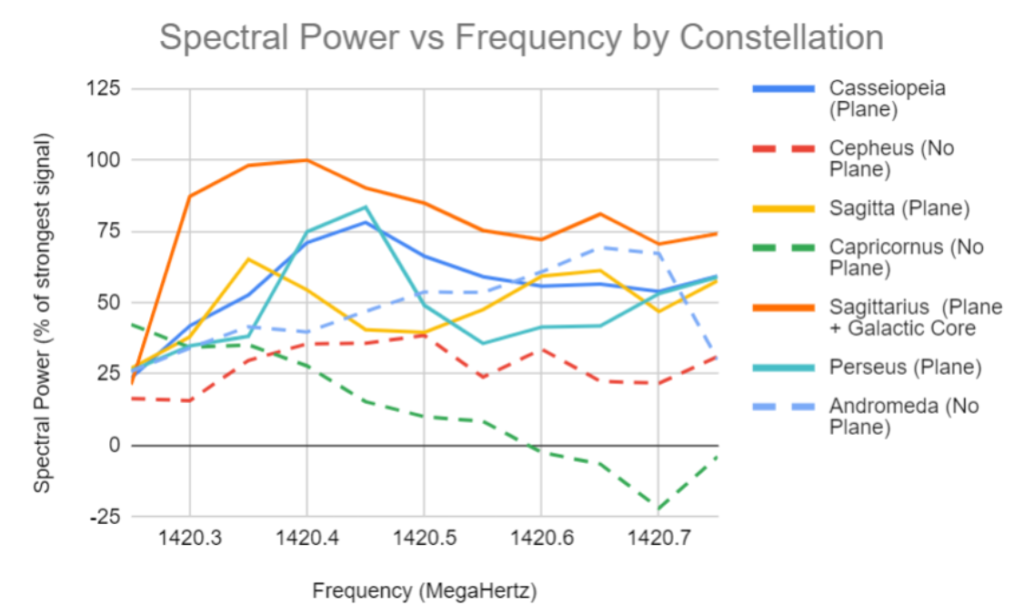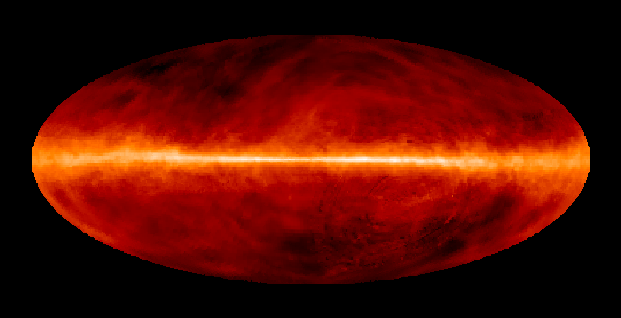In November 2020, Oscar Le, a high school teacher from Northern Virginia, contacted us on behalf of one of his students, Sam Watchman. In the spirit of Grote Reber, Sam built a radio receiver in his backyard for a science fair project. He collected radio data to compare the hydrogen in constellations with a galactic plane versus hydrogen in constellations outside a galactic plane, and needed some assistance to verify his results. One of our scientists, Jim Braatz, reached out to help clarify the results of Sam’s observation. Then Education and Public Outreach invited Sam to write a post about his experience.
I did this project for my high school science fair at Arlington Tech High School in Arlington, Virginia, where I am currently a freshman. For my project, I used my radio telescope to look at the hydrogen line signal in various parts of the sky (constellations). I hypothesized that constellations that are on the plane of the Milky Way galaxy would have higher signal levels than ones that are not on the galactic plane, and this hypothesis was supported.
Most radio astronomy research is conducted with giant antennas, like the ones at NRAO’s Very Large Array in New Mexico, or its Atacama Large Millimeter Array in Chile. These are giant, expensive instruments, which expand our knowledge of the universe but are only available for scientific institutions and governments.
However, there are ways that everyday people and schools can get involved in radio astronomy, driven by new low-cost radio technologies. The biggest example of this is Software Defined Radio, a technology that moves most of the radio signal processing hardware into software. This makes it very flexible for many applications. A Software Defined Radio can receive radio signals from a wide range of radio frequencies, including airplane transponder tracking, weather satellite image decoding, and notably, observations of hydrogen—the most abundant substance in space—in the Milky Way Galaxy.
When an electron in a hydrogen atom changes its spin state, they emit a photon (particle of light) at a specific frequency, which conveniently is in the range of Software Defined Radio modules, and correspond to a wavelength of 21 centimeters. However, it isn’t just like tuning in to a radio station —the signal is still very faint, and out of reach of basic radio antennas.
In order to receive the signal, we need a better antenna, one that can gather more photons of light. A good, simple design for this is the horn antenna, which I have built in my backyard in Virginia. It uses a large, flaring box shape, similar to the shape of a horn, to collect and guide the radio signal towards the receiving electronics. The shape is made from cardboard, with a wood frame to reinforce it, and the antenna is lined on the inside with aluminum foil to reflect the radio waves.
Once the signal is guided by the horn antenna, it is received by a short wire that is ¼ wavelength long. However, the signal is still too faint to just plug the wire into the Software Defined Radio, so we need an amplifier to boost the signal and make it detectable. This is attached directly to the antenna wire, and the output is connected to the Software Defined Radio. The Software Defined Radio is then plugged in to a laptop for signal processing.

Looking at the data, it is clear that most of the constellations within the galactic plane have noticeable signal power peaks near the 21 cm line at a frequency of 1420.4 MHz. However, some of these peaks are slightly off of the specific frequency itself. This is because of the Doppler Effect (an example of it is the pitch change of a car noise as it drives by). Essentially, the Doppler Effect means that a frequency of light or sound will shift if the source is moving relative to the observer. Because we live in a spiral galaxy, with all of the hydrogen and stars orbiting the center, the relative speed can be up to 200 kilometers per second, enough to noticeably shift the signal. If the part of the galaxy is coming towards us, then the signal is shifted to a higher frequency, and if it is moving away, a lower one. Through this, it is possible to map the galaxy’s spiral arms and rotation speed.
Personally, I became interested in radio astronomy by looking online at all of the interesting projects people have done. The design for this telescope is derived from many articles about studying the 21cm hydrogen line. However, it is not perfect; there are many things that can be improved. This was one of my first radio astronomy projects, and the first astronomy science fair project I have done. When I grow up, hopefully, I will get to use the instruments of radio astronomy which are much more advanced than my contraption of cardboard and aluminum foil.






